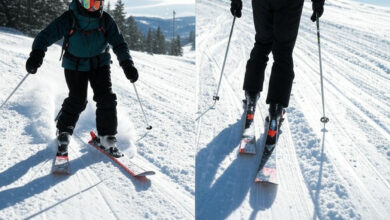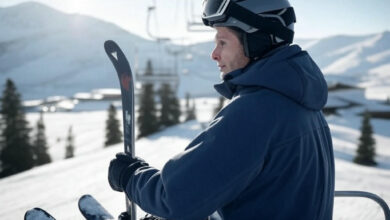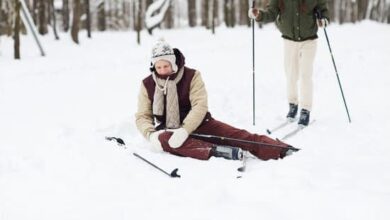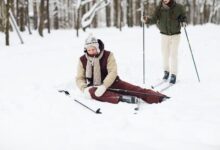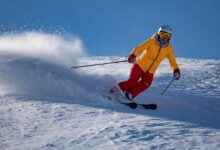Are Ski Jackets Warm? Buyer’s Guide for New Skiers
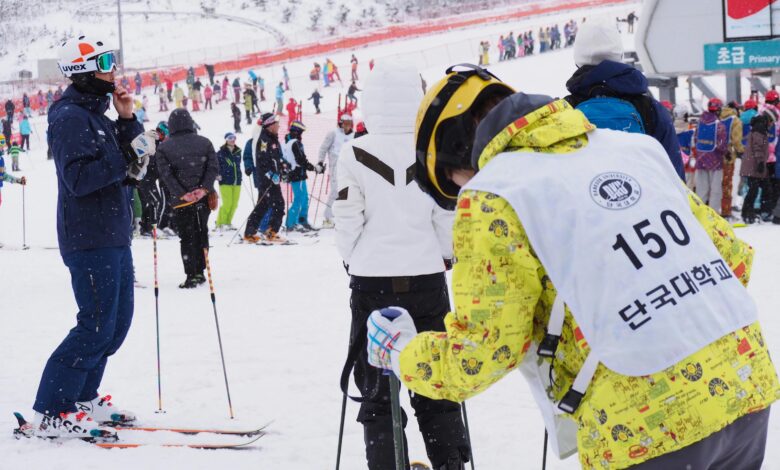
A ski jacket isn’t just a fashion statement; it’s your shield against the wind, snow, and cold, keeping your core warm and protected so you can enjoy your day. Hitting the slopes for the first time? Awesome! You’re going to need the right gear, and a good ski jacket is right at the top of that list.
But here’s the big question: Are ski jackets warm enough? Can’t you just wear an old winter coat?
The short answer: Yes, ski jackets are designed to be warm, but the level of warmth can vary a lot. Think of it like this: some ski jackets are built for mild days, while others are made to handle seriously frigid conditions. You wouldn’t wear a T-shirt in the snow, so don’t expect a regular jacket to cut it on the mountain.
You’ll find everything from lightweight, waterproof shell ski jackets to insulated ski jackets with built-in fleece linings. The colder the forecast, the warmer you’ll want your ski jacket to be.
Now, here’s a crucial point: Thicker doesn’t always mean warmer. Breathability is key! A good ski jacket will wick away sweat, preventing you from getting damp and chilled from the inside out. Imagine working up a sweat carving those turns and then getting soaked in your own perspiration – not fun!
Choosing the Right Ski Jacket: Your Go-To Guide
Shopping for ski jackets can feel overwhelming with all the options and price tags. That’s why I’ve put together this guide, breaking down everything you need to know to find the perfect ski jacket, whether you’re a complete beginner or looking to upgrade your gear. Let’s dive in!
Contents
- 1 Key Features of a Perfect Ski Jacket
- 2 Ski Jacket Areas
- 3 Ski Jacket Types
- 4 What’s the Difference Between Men and Women’s Ski Jackets?
- 5 Conclusion:
Key Features of a Perfect Ski Jacket
When you’re looking to buy ski jacket that will keep you comfortable and protected on the slopes, several key features come into play. Not all ski jackets are created equal, and understanding these factors will help you make the right choice, whether you’re shopping for ski coats Canada or searching for ski jackets Atlanta.

1. Breathability: Letting Your Body Breathe on the Mountain
Breathability refers to a ski jacket’s ability to allow moisture vapor (sweat) to escape, preventing you from becoming damp and cold. When you’re skiing, even in cold weather, your body generates heat and sweat. If that moisture stays trapped inside your jacket, it can quickly lead to a chilling effect, making you miserable and even increasing your risk of hypothermia. Choosing a breathable ski jacket is crucial for maintaining a comfortable body temperature, especially during high-exertion activities. This is very crucial to keeping you warm and at the best temp for skiing.
Breathability is typically measured in grams of moisture vapor that can pass through one square meter of fabric over 24 hours (g/m²/24h). A jacket with a breathability rating of 10,000 g/m²/24h or higher is generally considered good for moderate activity, while a rating of 20,000 g/m²/24h or higher is ideal for more intense skiing or snowboarding. Consider that the human body can produce around 1 liter of sweat per hour during intense physical exertion.
Materials like Gore-Tex, eVent, and other proprietary breathable membranes are commonly used in high-quality ski jackets to provide both waterproofing and breathability. These membranes have microscopic pores that allow moisture vapor to escape while preventing water from entering. Some ski jackets also feature ventilation zippers (pit zips) under the arms, which can be opened to increase airflow and further regulate body temperature. If you plan on doing some intense skiing you want to make sure you have breathable ski jackets Europe has a wide range of breathable ski jackets.
When you’re comparing ski jackets check the breathability rating. High breathability is especially important if you live in a warmer climate or plan to ski in varying conditions.
NOT Recommended Breathability Rating ❌
- 2-5,000mm is an ok baseline for on-piste skiing in cold but dry weather with regular breaks. Cheaper options but they are not very comfortable for long days of moderate skiing.
Recommended Breathability Rating ✅
- 5-10,000mm is better for long skiing days, where you will sweat more in all weather conditions.
- 10-20,000mm is ideal for wetter, snowier climates and for increased snow contact like backcountry and off-piste skiing. Recommended for most skiers.
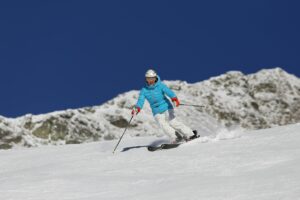
Note: The breathability of a jacket is measured in millimeters (mm), ranging from 2,000mm to 28,000mm. A higher number indicates greater breathability, allowing for better airflow and moisture management within the jacket.
2. Waterproofing: Staying Dry in Any Weather
Waterproofing is arguably the most critical feature of a ski jacket. A waterproof jacket prevents snow, rain, and sleet from penetrating the fabric, keeping you dry and comfortable. There’s nothing worse than being soaked through when you’re miles from the lodge. In cities like ski jackets Houston where precipitation can be unpredictable, or ski jackets Miami where a spring skiing trip might involve wet snow, waterproofing becomes even more important.
Waterproof ratings are measured in millimeters (mm) of water that the fabric can withstand before leaking. A rating of 5,000 mm is considered water-resistant and suitable for light rain or snow, while a rating of 10,000 mm is waterproof for moderate conditions. Jackets with a rating of 20,000 mm or higher are considered highly waterproof and can withstand heavy rain, snow, and even prolonged exposure to wet conditions. While some people in cities like ski jackets new York, ski jackets nyc, ski jackets salt lake city may think they don’t need a good ski jacket, but in the cold winter months when snowfall becomes heavy, you would not want to be caught without a ski jacket that would protect you from getting wet.
Look for ski jackets that have a Durable Water Repellent (DWR) finish applied to the outer fabric. This coating helps water bead up and roll off the surface of the jacket, further enhancing its waterproofness. Seams are another critical factor; fully taped seams prevent water from seeping through the stitching. Many premium ski jackets, like the ones in ski jackets Canada and usa ski jacket collections, feature fully taped seams and high waterproof ratings to ensure maximum protection.

Outer Layer
The outermost layer of a ski jacket is the part that comes in direct contact with snow. It is typically constructed from durable nylon or polyester fabric, featuring vibrant prints, patterns, or solid color coatings. To provide the first line of defense against moisture, this layer is treated with a durable water-repellent (DWR) coating, ensuring that snow and light rain bead off the surface instead of soaking through.
Membrane Barrier
The membrane layer plays a crucial role in maintaining both waterproofing and breathability. It prevents external water droplets from penetrating the fabric while allowing moisture from sweat to escape. Most ski jackets use Teflon-based or polyurethane membranes, striking a balance between water resistance and ventilation. This technology helps skiers stay dry and comfortable, even in wet or high-intensity conditions.
Inner Layer
The inner lining of a ski jacket is typically composed of lightweight mesh fabric, bonded to the outer layers. This mesh material enhances airflow, preventing moisture buildup inside the jacket while also acting as a protective barrier for the membrane layer. Ski jackets usually come in two variations:
- 2-layer construction – More affordable but bulkier and less breathable.
- 3-layer construction – More expensive, yet offers superior breathability, durability, and long-term water resistance.
Premium ski jackets also feature reinforced stitching, high-quality materials, and advanced waterproof coatings, all of which contribute to enhanced longevity and protection against harsh winter conditions.
Waterproof Ratings 💦
Ski jackets are rated based on their water resistance levels, measured in millimeters (mm). Higher ratings indicate better protection against moisture.
| Rating (mm) | Water Resistance Level |
|---|---|
| 0 – 5,000 mm | Minimal to no water resistance |
| 6,000 – 10,000 mm | Moderate water resistance, suitable for light snowfall |
| 11,000 – 15,000 mm | Standard resistance, ideal for most skiing conditions |
| 16,000 – 20,000 mm | High resistance, effective in wet and snowy environments |
| 20,000 mm+ | Maximum protection, ideal for extreme weather |

Skiers who frequently encounter wet or heavy snowfall should opt for jackets with 16,000mm+ ratings, ensuring long-lasting waterproofing and comfort in challenging conditions.
NOT Recommended Waterproof Rating ❌:
- 5,000mm or lower – Bad: Only water resistant. Not fun to ski in if you fall into the snow a few times or it starts to snow.
- 5-10,000mm – OK: Will be ok in fair weather skiing, but when it snows you will get wet within an hour.
Recommended Waterproof Rating ✅:
- 10,000 mm – Minimum baseline: Look for skiing jackets at this level or higher. This will keep you dry for a few hours in bad weather and some contact with the snow.
- 15,000 mm – Decent waterproofing, this will keep you dry most of the day in bad weather.
- 20,000 mm – Excellent waterproofing. Will keep you dry all day in snowy conditions.
- 28,000 mm – Extreme waterproofing. Will keep you dry all day in snowy conditions. The best waterproofing levels, are usually GoreTex. Expect to pay decent money for this level of protection.
Consider your typical skiing conditions when choosing a waterproof rating. If you often ski in wet, heavy snow or rain, opt for a jacket with a higher waterproof rating.
3. Warmth: Battling the Cold for Optimal Comfort
Warmth is a subjective factor but crucial for enjoying your time on the slopes. A warm ski jacket will keep you comfortable and prevent hypothermia in cold conditions. The level of warmth you need depends on the climate you ski in, your activity level, and your personal preference. Cities like Ski Jackets Chicago or when looking for Ski Coats Canada require jackets with high insulation levels due to the harsh winter conditions.
Ski jackets typically use two types of insulation: down and synthetic. Down insulation is made from the fluffy undercoating of ducks or geese and provides an excellent warmth-to-weight ratio. However, down loses its insulating properties when wet. Synthetic insulation, such as PrimaLoft or Thinsulate, is made from synthetic fibers that retain their warmth even when damp.
The amount of insulation in a ski jacket is measured in grams per square meter (g/m²). A jacket with 60-80 g/m² of insulation is suitable for mild conditions, while a jacket with 100-140 g/m² is better for colder weather. Jackets with 150 g/m² or more are designed for extremely cold conditions. Some us ski jacket brands offer jackets with adjustable insulation, allowing you to customize the warmth level based on the weather.
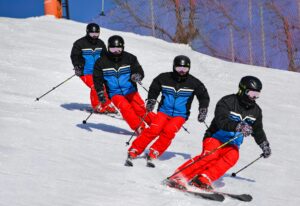
When choosing a warm ski jacket, consider layering. Wearing a base layer and a mid-layer under your jacket can significantly increase your warmth. Layering allows you to adjust your insulation based on the conditions.
4. Durability: A Jacket That Will Last Through the Seasons
A durable ski jacket is an investment that will last for many seasons. Skiing can be tough on your gear, with constant exposure to snow, ice, and abrasion from skis and poles. A well-made ski jacket will withstand these conditions and continue to perform year after year.
Look for ski jackets made from high-quality materials, such as nylon or polyester with a durable weave. Higher denier fabrics (e.g., 75D or 150D) are more resistant to abrasion and tearing. Reinforced areas, such as the shoulders and elbows, can further enhance durability. For example, ski jackets Atlanta that are frequently taken on trips to more rugged locations need to be made from durable material.
Check the construction of the jacket. Look for strong stitching, reinforced seams, and quality zippers and closures. YKK zippers are known for their durability and reliability. Many ski jackets Europe have high-quality zippers that stand the test of time.
Proper care can also extend the lifespan of your ski jacket. Follow the manufacturer’s instructions for washing and drying, and reapply DWR finish as needed to maintain its waterproofness.
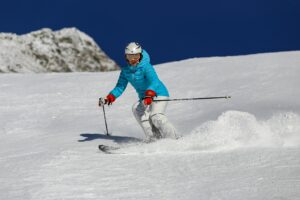
5. Pockets: Storage and Convenience on the Slopes
Pockets are an often-overlooked feature, but they can make a big difference in your overall experience on the slopes. A good ski jacket should have a variety of pockets for storing essentials like your phone, wallet, ski pass, goggles, and snacks.
Look for a dedicated ski pass pocket on the sleeve, which allows for easy scanning at the lift. Interior pockets are great for storing valuables or items that you want to keep warm, such as your phone or a camera battery. A goggle pocket lined with a soft material will protect your lenses from scratches. Handwarmer pockets lined with fleece or other insulating material can provide extra warmth on cold days. Choosing the right usa ski jacket could mean having the optimal amount of pockets.
Consider the size and placement of the pockets. Make sure they are easily accessible even when you’re wearing gloves, and that they are large enough to hold the items you need to carry. Zippers or closures will keep your belongings secure.
6. Fit and Features: Comfort and Functionality Combined
The fit of your ski jacket is crucial for both comfort and performance. A jacket that is too tight will restrict your movement, while a jacket that is too loose will let in cold air and snow. Look for a jacket that allows you to move freely without feeling bulky. Ski Jackets Salt Lake City for example typically have to be fit well so the user can have optimal mobility in the slopes.
Articulated elbows and shoulders provide a greater range of motion, allowing you to move more naturally. Adjustable cuffs and a drawcord hem allow you to customize the fit and seal out drafts. A removable hood provides versatility in different weather conditions. Many Ski Coats Canada include hoods, but these are easily removed.
Other features to consider include a powder skirt, which prevents snow from entering your jacket at the waist, and a helmet-compatible hood, which provides extra protection in cold or windy conditions. A built-in RECCO reflector can help rescuers locate you in the event of an avalanche.
By considering these key features, you can find a ski jacket that will keep you warm, dry, and comfortable on the slopes, no matter where you’re skiing!
Ski Jacket Areas
Choosing the right ski jacket involves more than just looking at overall features like breathability and warmth. Paying attention to specific areas of the jacket can significantly impact your comfort and performance on the slopes. Here’s a breakdown of the key areas:
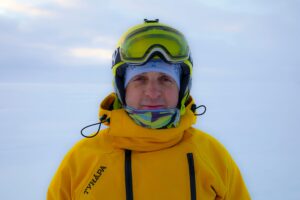
Hood: Protection from the Elements Above
The hood is your first line of defense against snow, wind, and cold rain. A well-designed hood can make a huge difference in your comfort, especially on blustery days.
-
Helmet Compatibility: This is a must for most skiers. A helmet-compatible hood is large enough to comfortably fit over your ski helmet without restricting your vision or movement. It should also have adjustments that allow you to tighten it around your helmet for a snug fit. Some hoods have a special design that allows them to expand and contract easily around a helmet.
-
Adjustment Options: Look for multiple adjustment points on the hood. Drawcords or toggles at the front and back of the hood allow you to customize the fit and prevent wind and snow from entering. A hood with a wired brim can also provide added protection and visibility.
-
Removability: Some ski jackets have removable hoods, which can be convenient for milder days or when you prefer not to wear a hood. A removable hood should attach securely to the jacket and be easy to remove and reattach.
-
Insulation: A hood with insulation can provide extra warmth and protection for your head and neck. Consider the level of insulation based on your typical skiing conditions. A lined hood will ensure that your skin does not come into contact with the elements directly.
Cuffs: Sealing in Warmth and Preventing Snow Entry
The cuffs of your ski jacket play a crucial role in sealing in warmth and preventing snow from entering your sleeves. A well-designed cuff system will keep your hands warm and dry.
-
Adjustability: Look for cuffs that are adjustable using Velcro straps or snap closures. This allows you to customize the fit and seal out drafts. The cuffs should be snug enough to prevent snow from entering, but not so tight that they restrict circulation.
-
Gaiters or Inner Cuffs: Many ski jackets feature inner cuffs or wrist gaiters made of stretchy material, such as Lycra or spandex. These gaiters fit snugly around your wrists and provide an extra layer of protection against snow and wind. Some gaiters even have thumbholes to keep them in place.
-
Reinforcements: Cuffs are prone to wear and tear, so look for jackets with reinforced cuffs made of durable materials like nylon or Cordura.
-
Glove Compatibility: Consider how the cuffs of your ski jacket will interact with your gloves. Some jackets have longer cuffs that extend over the gloves, while others have shorter cuffs that fit inside the gloves. Choose a style that works best for your preferred glove type.
Vents: Regulating Temperature on the Go
Vents are essential for regulating your body temperature during physical activity. They allow you to release excess heat and moisture, preventing you from becoming overheated and sweaty.
-
Pit Zips: Pit zips, located under the arms, are the most common type of vent on ski jackets. These zippered openings can be opened or closed to allow for airflow. Look for pit zips that are lined with mesh to prevent snow from entering. It is always a good idea to invest in a jacket with pit zips, especially for beginners since beginners often make mistakes that require a bit more work and this can get the body temperature up.
-
Back Vents: Some ski jackets also have vents on the back, which can provide additional airflow. These vents are typically located near the shoulders or along the back panel.
-
Zipper Placement: Pay attention to the placement of the zippers on the vents. They should be easy to reach and operate even when you’re wearing gloves.
-
Water Resistance: Vents should be designed to prevent water from entering when closed. Look for zippers that are covered with flaps or that are water-resistant.
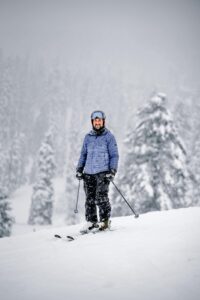
Pockets: Storage Solutions for Your Essentials
Pockets provide convenient storage for your essentials on the slopes, such as your phone, wallet, ski pass, goggles, and snacks. A well-designed pocket system will keep your belongings organized and easily accessible.
-
Ski Pass Pocket: A dedicated ski pass pocket on the sleeve is a must for easy scanning at the lift. These pockets are typically located on the left sleeve and have a clear window for displaying your ski pass.
-
Handwarmer Pockets: Handwarmer pockets lined with fleece or other insulating material can provide extra warmth on cold days.
-
Interior Pockets: Interior pockets are great for storing valuables or items that you want to keep warm, such as your phone or a camera battery. Some jackets have a dedicated media pocket with a cord port for headphones.
-
Goggle Pocket: A goggle pocket lined with a soft material will protect your lenses from scratches. Some goggle pockets also have a detachable goggle wipe.
-
Pocket Placement and Size: Consider the placement and size of the pockets. Make sure they are easily accessible even when you’re wearing gloves, and that they are large enough to hold the items you need to carry.
Zipper: The Gateway to Warmth and Protection
The zipper is a critical component of your ski jacket, as it secures the front closure and prevents wind and snow from entering. A high-quality zipper will be durable and reliable.
-
Type of Zipper: YKK zippers are known for their durability and reliability. Look for zippers that are water-resistant or waterproof to prevent moisture from seeping through.
-
Storm Flap: A storm flap that covers the zipper can provide extra protection against wind and snow. The storm flap should be secured with snaps or Velcro closures.
-
Zipper Pulls: Look for zipper pulls that are easy to grip and operate even when you’re wearing gloves.
-
Two-Way Zipper: A two-way zipper allows you to open the jacket from the top or bottom, providing ventilation and added comfort when sitting or bending over.
By considering these details in each area of the ski jacket, you’ll be well-equipped to choose a jacket that perfectly suits your needs and keeps you comfortable and protected on the slopes.
Nice to Have
When choosing a ski jacket, it’s important to look beyond just warmth and waterproofing. Modern ski jackets come with smart design features that enhance comfort, convenience, and protection on the slopes. Here are some of the most useful additions to look for:
Snap-to-Pants System
Many high-quality ski jackets include built-in poppers, zippers, hooks, or loops that allow you to securely attach your ski pants to your jacket. This creates a seamless fit, preventing snow from creeping in and providing better thermal insulation. It’s like bringing back the full-body snowsuit experience but with added flexibility and comfort.
Powder Skirt (Snow Skirt)
A powder skirt is an elastic band sewn into the lower interior of the jacket. It acts as a barrier against snow, keeping it from entering through the bottom of your jacket when you fall or ski through deep powder. This feature is especially useful for off-piste skiers and those who love fresh powder runs.
Protective Padding for Extra Safety
If you’re a beginner skier or someone who enjoys high-speed runs, a ski jacket with reinforced padding can be a game-changer. Extra cushioning in key areas (such as elbows, shoulders, and back) helps absorb impact from falls, reducing the risk of injuries and making skiing safer for those still mastering their technique.
Dedicated Audio/Phone Pocket
Staying connected or enjoying music while skiing is easier with a built-in audio or phone pocket. Some ski jackets feature a special hole for headphone wires, allowing you to route them discreetly to your ears. If you prefer a wireless experience, consider using Bluetooth headphones or ski helmets with integrated speakers for hands-free convenience on the slopes.
Goggle Storage Pocket
A goggle pocket is a large mesh compartment inside most ski jackets. It provides a safe and easily accessible spot to store your ski goggles when they’re not in use. This helps prevent scratches and fogging while keeping your gear organized and within reach.
Whether you’re a beginner or a seasoned skier, having these functional features in your ski jacket can greatly enhance your comfort, safety, and convenience on the slopes. When shopping for a ski jacket, look for designs that combine warmth, waterproofing, and practical storage solutions, ensuring a hassle-free skiing experience every time.
Ski Jacket Types
Choosing the right type of ski jacket is crucial for staying comfortable and protected on the slopes. Each type offers a different balance of warmth, waterproofing, and breathability, so understanding the nuances will help you make the best decision. When you buy ski jacket, consider this guide to assist you!
1. Shell Ski Jackets: Versatile Protection for Layering
Shell ski jackets are the most versatile option, offering excellent waterproofing and wind protection without any built-in insulation. This allows you to customize your warmth level by layering clothing underneath, making them suitable for a wide range of conditions. Shell jackets are a good choice for skiers who want a single jacket that can be used in both mild and cold weather. Shell jackets are a great choice if you’re in locations such as ski jackets Atlanta.
-
Key Features: Shell jackets are typically made from waterproof and breathable fabrics, such as Gore-Tex, eVent, or other proprietary membranes. They often have a Durable Water Repellent (DWR) finish to enhance water resistance. Look for fully taped seams to prevent water from seeping through the stitching.
-
Layering: The key to staying warm in a shell jacket is layering. Start with a moisture-wicking base layer, such as merino wool or synthetic fabric, to draw sweat away from your skin. Add an insulating mid-layer, such as a fleece or down jacket, for warmth. Adjust the number and thickness of your layers based on the temperature and your activity level.
-
Waterproof Rating: Shell jackets typically have a high waterproof rating, ranging from 10,000 mm to 20,000 mm or higher. The higher the rating, the more resistant the jacket is to water penetration.
-
Breathability Rating: Breathability is also important in a shell jacket. Look for a jacket with a breathability rating of 10,000 g/m²/24h or higher to prevent moisture buildup inside the jacket.
-
Best For: Skiers who want a versatile jacket that can be used in a variety of conditions, or those who prefer to customize their warmth level through layering. It is best for those who live in areas with fluctuating weather conditions.
2. Insulated Ski Jackets: Warmth Without the Fuss
Insulated ski jackets have built-in insulation, providing warmth without the need for multiple layers. These jackets are a good choice for skiers who prefer a simple, one-piece solution for staying warm on the slopes. These are the prime choice when looking for ski coats Canada.
-
Key Features: Insulated jackets typically use either down or synthetic insulation. Down insulation is made from the fluffy undercoating of ducks or geese and provides excellent warmth-to-weight ratio. However, down loses its insulating properties when wet. Synthetic insulation, such as PrimaLoft or Thinsulate, is made from synthetic fibers that retain their warmth even when damp.
-
Insulation Weight: The amount of insulation in a jacket is measured in grams per square meter (g/m²). A jacket with 60-80 g/m² of insulation is suitable for mild conditions, while a jacket with 100-140 g/m² is better for colder weather. Jackets with 150 g/m² or more are designed for extremely cold conditions, like when you buy ski jackets Chicago.
-
Waterproof Rating: Insulated jackets typically have a waterproof rating ranging from 5,000 mm to 20,000 mm or higher. Look for jackets with fully taped seams and a DWR finish for maximum water resistance.
-
Breathability Rating: Breathability is also important in an insulated jacket. Look for a jacket with a breathability rating of 5,000 g/m²/24h or higher to prevent moisture buildup inside the jacket.
-
Best For: Skiers who want a warm and convenient jacket for cold weather conditions. This is great for those who are looking for ski jackets Europe.

3. 3-in-1 Ski Jackets: The Ultimate in Versatility
3-in-1 ski jackets combine a waterproof shell jacket with a removable insulated liner, offering the ultimate in versatility. These jackets can be worn as a shell only, a liner only, or both together, making them suitable for a wide range of conditions. This is the best solution when you buy ski jacket if you plan to visit areas with varying weather.
-
Key Features: 3-in-1 jackets typically consist of a waterproof and breathable shell jacket and a removable insulated liner, which can be either a fleece jacket or a down or synthetic insulated jacket. The shell jacket provides waterproofing and wind protection, while the liner provides warmth.
-
Waterproof and Breathability Ratings: Look for 3-in-1 jackets with high waterproof and breathability ratings for both the shell and the liner. The shell should have a waterproof rating of 10,000 mm or higher, and a breathability rating of 10,000 g/m²/24h or higher.
-
Connection System: The shell and liner should have a secure connection system, such as zippers or snaps, to prevent them from separating during activity.
-
Versatility: The ability to wear the shell and liner separately or together makes 3-in-1 jackets a great choice for skiers who want a single jacket that can be used in a variety of conditions.
-
Best For: Skiers who want a versatile jacket that can be used in a wide range of conditions, or those who travel frequently and need a jacket that can adapt to different climates.
4. Softshell Ski Jackets: Breathable Comfort for Mild Conditions
Softshell ski jackets are made from soft, stretchy fabrics that provide excellent breathability and comfort. While not as waterproof as hardshell jackets, softshell jackets offer good water resistance and wind protection, making them suitable for mild conditions or high-activity skiing. Though they can be worn in most areas, they can be ideal for those in locations such as ski jackets Houston.
-
Key Features: Softshell jackets are typically made from woven fabrics, such as nylon or polyester, with a DWR finish. They are highly breathable and comfortable to wear, but they are not fully waterproof.
-
Water Resistance: Softshell jackets offer good water resistance, but they are not designed to withstand heavy rain or snow. They are best suited for dry conditions or light precipitation.
-
Breathability: Softshell jackets are highly breathable, making them ideal for high-activity skiing or mild weather conditions.
-
Stretch: The stretchy fabric of softshell jackets allows for a full range of motion, making them comfortable to wear during physical activity.
-
Best For: Skiers who ski in mild weather conditions or who prioritize breathability and comfort over waterproofness.
By understanding the different types of ski jackets, you can choose the one that best suits your needs and skiing style.
Ski Jacket Fit
Understanding ski jacket fit is crucial for both comfort and performance on the slopes. A well-fitting ski jacket will allow for freedom of movement, keep you warm and dry, and accommodate layering. Here’s a breakdown of the key aspects of ski jacket fit:
1. Overall Length:
-
Ideal: The jacket should reach roughly to the middle of your butt. This provides good coverage for your core and back, especially when sitting on chairlifts.
-
Too Short: Will leave your lower back exposed when bending over or sitting, letting in cold air and snow.
-
Too Long: Can restrict movement and potentially interfere with your ski boots or pants. Too much excess fabric can also be cumbersome and feel bulky.
2. Chest and Torso Fit:
-
Ideal: You should be able to comfortably zip the jacket closed with your typical layering system (base layer, mid-layer fleece or sweater). You should have enough room to move your arms freely without feeling restricted. Imagine reaching forward, as if grabbing a ski pole – the jacket shouldn’t feel tight across your chest or back.
-
Too Tight: Restricts movement, makes layering difficult, and can be uncomfortable. It also compresses insulation, reducing its effectiveness.
-
Too Loose: Allows cold air to circulate, reducing warmth. Excess fabric can also flap in the wind and be distracting.
3. Shoulder and Arm Movement:
-
Ideal: You should have a full range of motion in your arms and shoulders without the jacket riding up or feeling tight. Test this by reaching your arms overhead and across your body. The shoulder seams should sit comfortably at the edge of your shoulders, not drooping down your arms.
-
Too Tight: Restricts arm movement, making it difficult to reach forward or overhead. Can also cause the jacket to ride up, exposing your midriff.
-
Too Loose: Creates excess bulk and allows cold air to enter through the armholes.
4. Sleeve Length:
-
Ideal: The sleeves should extend to the base of your thumb when your arms are relaxed at your sides. When you raise your arms forward, the sleeves should still cover your wrists, preventing gaps between your gloves and jacket. Many ski jackets have adjustable cuffs to fine-tune the fit.
-
Too Short: Leaves your wrists exposed, letting in cold air and snow.
-
Too Long: Gets in the way when you’re skiing or snowboarding, and can be caught on equipment.
5. Hood Fit:
-
Ideal: The hood should fit comfortably over your head with a helmet. It should have adjustable drawcords or toggles to cinch it down when not wearing a helmet or in windy conditions. It should also provide good peripheral vision.
-
Too Small: Won’t fit over a helmet or will feel restrictive and uncomfortable.
-
Too Large: Obscures your vision and is difficult to keep in place in windy conditions.
6. Layering Considerations:
-
Plan Your Layers: When trying on a ski jacket, wear the type of base layer and mid-layer you would typically wear while skiing. This is crucial for getting the right fit.
-
Room for Movement: Ensure you have enough room to move comfortably with your layers on.
-
Avoid Over-Layering: A good ski jacket and appropriate base and mid-layers should be sufficient for most conditions. Over-layering can lead to overheating and sweating, which can then make you cold.
7. Style Considerations:
-
Athletic/Slim Fit: A more streamlined, fitted silhouette that prioritizes performance. Often preferred by skiers who are more active and want less bulk. Requires careful layering.
-
Regular/Classic Fit: A more relaxed fit that allows for greater layering flexibility. A good all-around option.
-
Relaxed/Loose Fit: A roomier fit that provides maximum freedom of movement. Popular with snowboarders or those who prefer a more casual look.
Tips for Finding the Right Fit:
-
Try Before You Buy: Whenever possible, try on ski jackets in person, wearing your typical layers.
-
Move Around: Don’t just stand still while trying on a jacket. Mimic skiing motions to see how the jacket feels and performs.
-
Read Reviews: Online reviews can provide valuable insights into the fit and performance of a particular jacket.
-
Consider Your Activity Level: If you’re a highly active skier, you may prefer a more athletic fit. If you’re more casual, a relaxed fit may be more comfortable.
-
Prioritize Comfort and Performance: Ultimately, the best-fitting ski jacket is the one that feels comfortable, allows you to move freely, and keeps you warm and dry on the slopes.
By paying attention to these details, you can find a ski jacket that fits properly and enhances your experience on the mountain.
What’s the Difference Between Men and Women’s Ski Jackets?
The primary differences between men’s and women’s ski jackets are centered around fit and design, tailored to accommodate the typical anatomical differences between male and female bodies. While technology and features can be identical, shaping and cutting are key to providing optimal comfort and performance.
Here’s a breakdown of the main distinctions:
-
Fit:
-
Torso Shape: Women’s jackets are typically cut with a more hourglass shape, narrower at the waist and wider at the hips and bust, to better conform to the female form. Men’s jackets have a straighter, more rectangular cut.
-
Shoulder Width: Women’s jackets generally have narrower shoulders than men’s jackets of the same size. This prevents the jacket from feeling bulky or oversized on the shoulders.
-
Sleeve Length: Women’s sleeves tend to be shorter relative to chest size compared to men’s sleeves.
-
Overall Length: The overall length might be slightly different in proportion to the torso fit.
-
-
Design Features (Sometimes):
-
Insulation: While both genders can have equal insulation, sometimes women’s jackets might have slightly more insulation in the core area due to typically lower body temperature.
-
Color and Style: Women’s jackets often come in a wider range of colors and patterns than men’s jackets. This is purely aesthetic and not related to performance.
-
Hood Size: Hood size can be adjusted in both, however, women’s jackets sometimes feature hoods that accommodate hairstyles and headwear better.
-
-
Performance:
-
Functionally Identical: In terms of waterproofing, breathability, and wind resistance, there are no inherent differences in performance between men’s and women’s ski jackets as long as they use the same materials and construction techniques. The fit is what will impact performance more.
-

Here’s a table summarizing the differences:
| Feature | Men’s Ski Jackets | Women’s Ski Jackets |
| Overall Fit | Straighter, more rectangular cut | Hourglass shape, tailored to curves |
| Torso Shape | Straighter, less defined waist | Narrower waist, wider hips and bust |
| Shoulder Width | Wider shoulders for the same chest size | Narrower shoulders for the same chest size |
| Sleeve Length | Typically longer relative to chest size | Typically shorter relative to chest size |
| Overall Length | Varies, but can be a slightly longer cut. | Varies, but can be a slightly shorter cut. |
| Insulation | Can be the same as women’s jackets. | Can be the same as men’s jackets; sometimes more in the core |
| Colors/Styles | Generally fewer color/style options | Generally wider range of color/style options |
| Hood Design | Functional and performance-focused | Functional, performance-focused, possibly more options for hairstyles |
| Performance | Waterproofing, breathability, and wind resistance are equal to those in women’s jackets. | Waterproofing, breathability, and wind resistance are equal to those in men’s jackets. |
Important Considerations:
-
Gender-Neutral Jackets: Some brands offer gender-neutral or unisex ski jackets. These jackets typically have a straighter cut similar to men’s jackets.
-
Personal Preference: The best jacket is the one that fits you the best, regardless of the labeled gender. Some women may prefer the fit of a men’s jacket, and vice versa.
-
Try On: Always try on jackets before buying, if possible, to ensure a proper fit.
Ultimately, the key takeaway is that the best ski jacket for you is the one that fits you comfortably and allows you to move freely while providing the necessary warmth and protection from the elements. Don’t be afraid to try on jackets from both the men’s and women’s sections to find the perfect fit.
Conclusion:
While men’s and women’s ski jackets share the same purpose—keeping you warm, dry, and comfortable on the slopes—their differences in fit, insulation, design, and features cater to the unique needs of each gender.
If you prioritize a tailored fit with contoured insulation and a stylish design, a gender-specific ski jacket is the best choice. However, if functionality and comfort are your main concerns, exploring unisex or alternative fits may provide better flexibility.
Ultimately, the right ski jacket is the one that fits your body type, skiing style, and weather conditions while ensuring maximum warmth and mobility. Whether you choose a men’s or women’s ski jacket, always focus on waterproofing, breathability, insulation, and comfort for an optimal skiing experience. 🎿❄️


